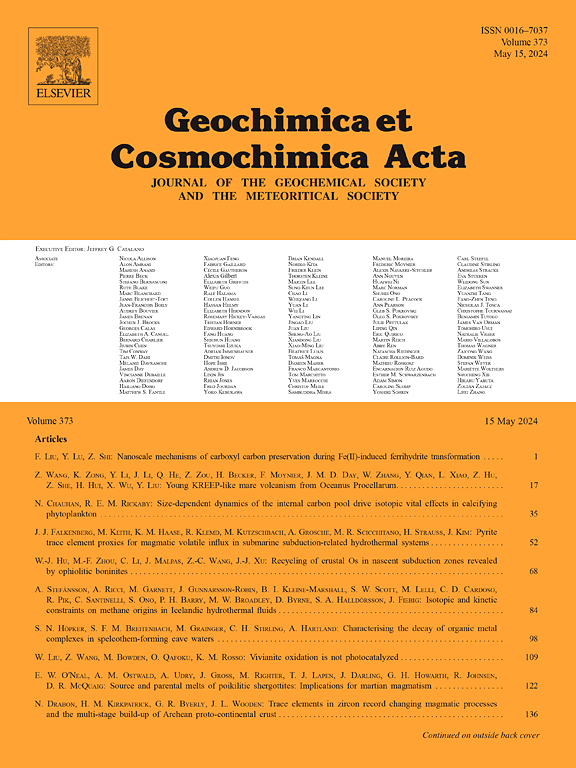Antimony(V) reaction with particulate natural organic matter: Sorption behavior, binding mechanism, and environmental implications
IF 4.5
1区 地球科学
Q1 GEOCHEMISTRY & GEOPHYSICS
引用次数: 0
Abstract
Antimony (Sb) is a metalloid extensively used in industrial products with a high potential for accumulation in organic-rich soils. Under oxic conditions, dissolved Sb occurs in its pentavalent oxidation state, Sb(V), but little is known about sorptive interactions between Sb(V) and natural organic matter (OM). Therefore, we conducted batch experiments with Sb(V) and particulate OM (POM) of peat as a model sorbent for particulate soil OM. We varied reaction time (1–21 d), concentrations of Sb(V) (1–218 µM) and POM (1–5 g L−1), pH (1.5–10.5), as well as type (NaCl and CaCl2) and concentration of the background electrolyte (no salt, 0.01 and 0.1 M). Additionally, we explored the molecular mechanism of Sb(V) binding to POM at pH ≤ 4 using X-ray absorption spectroscopy. Based on this information, we modelled Sb(V) sorption data with the Stockholm Humic Model (SHM). Sorption of Sb(V) to POM did not cause Sb reduction and decreased from 109 mmol kg−1 at pH 3 to 72.4 mmol kg−1 at pH 5 (1 g L−1 POM, 0.01 M NaCl). Although sorption maxima were found at pH 1.8–2.8, up to ∼ 10 % of total Sb(V) was still removed from solution at pH 6. An increase in POM concentration, ionic strength, and the presence of Ca2+ promoted Sb(V) sorption. The high Sb(V) sorption capacity of POM was associated with a low binding affinity. Sorption kinetics of Sb(V) were slow and generally showed bi-phasic patterns. Apparent half-life times of the fast and slow sorption process at pH 4 and 5 were on average 12.7 and 117 h, respectively. The slowly sorbing Sb(V) was ascribed to diffusion of Sb(V) into net-negatively charged POM particles. X-ray absorption spectroscopy analyses showed 6.3 ± 0.4 O atoms at 1.98 ± 0.01 Å (mean ± SD), followed by 2.1 ± 0.4 C atoms at 2.82 ± 0.05 Å, implying pentavalent Sb in octahedral coordination and bidentate complexation by polycarboxylic, hydroxy-carboxylic, and/or polyol ligands in 5- or 6-membered ring structures. The SHM accurately described Sb(V) sorption edges and sorption isotherm data collected at pH 3–5. SHM calculations implied that Sb(V) sorption to POM may be quantitatively relevant even at pH > 7 and impairs the precipitation of Ca-antimonates at acidic pH. We also predicted competition effects showing that Al, Pb, and MoO42− can cause substantial desorption of Sb(V) when present in excess over Sb(V). Model predictions also indicated that Sb(V) complexation by POM in organic soils becomes negligible in presence of > 1 wt% metal oxides. Overall, our results show that although POM has an enormous potential for Sb(V) sequestration over a broad pH range, competing ions and mineral sorbents may strongly decrease Sb(V) binding by POM. This implies that Sb(V) binding to POM is only relevant in oxic metal-poor soil environments such as ombrotrophic peats, organic surface layers, and OM-rich microenvironments of mineral soils.
锑(V)与天然有机微粒的反应:吸附行为、结合机制及环境影响
锑是一种广泛应用于工业产品的类金属,在富有机质土壤中具有很高的富集潜力。在氧化条件下,溶解的Sb以其五价氧化态Sb(V)发生,但Sb(V)与天然有机物(OM)之间的吸附相互作用知之甚少。因此,我们以泥炭中的Sb(V)和颗粒性OM (POM)作为颗粒性土壤OM的模型吸附剂进行了批量实验。我们改变了反应时间(1 - 21 d), Sb(V)(1 - 218 µM)和POM(1 - 5 g L−1)的浓度,pH(1.5-10.5),以及类型(NaCl和CaCl2)和背景电解质浓度(无盐,0.01和0.1 M)。此外,我们还利用x射线吸收光谱研究了pH ≤ 4时Sb(V)与POM结合的分子机制。基于这些信息,我们用斯德哥尔摩腐殖质模型(SHM)模拟了Sb(V)的吸附数据。Sb(V)对POM的吸附不引起Sb的还原,从pH 3时的109 mmol kg−1降至pH 5时的72.4 mmol kg−1(1 g L−1 POM, 0.01 M NaCl)。虽然在pH 1.8-2.8时发现了最大的吸附,但在pH 6时仍能从溶液中去除高达 ~ 10 %的总Sb(V)。POM浓度、离子强度的增加和Ca2+的存在促进了Sb(V)的吸附。POM的高Sb(V)吸附能力与低结合亲和力有关。Sb(V)的吸附动力学缓慢,一般呈双相模式。在pH 4和pH 5条件下,快速和慢速吸附过程的表观半衰期平均分别为12.7和117 h。Sb(V)的缓慢吸附归因于Sb(V)在净负电荷POM颗粒中的扩散。x光吸收光谱分析显示6.3 ±0.4 O原子在1.98 ±0.01 (平均 ± SD),其次是 2.1±0.4 C原子 2.82±0.05 ,暗示五价的某人在八面体的协调和双齿多羧酸的络合,hydroxy-carboxylic和/或多元醇配体5 -或六元环结构。该模型准确地描述了pH值为3 ~ 5时Sb(V)的吸附边和吸附等温线数据。SHM计算表明,即使在pH >下,Sb(V)对POM的吸附也可能与定量相关;我们还预测了竞争效应,表明当Al、Pb和MoO42−的含量超过Sb(V)时,会导致Sb(V)的大量解吸。模型预测还表明,在存在 >; 1 wt%金属氧化物的情况下,有机土壤中POM对Sb(V)的络合作用可以忽略不计。总体而言,我们的研究结果表明,尽管POM在广泛的pH范围内具有巨大的Sb(V)封存潜力,但竞争离子和矿物吸附剂可能会强烈降低POM对Sb(V)的结合。这表明Sb(V)与POM的结合仅与含氧金属贫乏的土壤环境有关,如疏养泥炭、有机表层和富含om的矿物土壤微环境。
本文章由计算机程序翻译,如有差异,请以英文原文为准。
求助全文
约1分钟内获得全文
求助全文
来源期刊

Geochimica et Cosmochimica Acta
地学-地球化学与地球物理
CiteScore
9.60
自引率
14.00%
发文量
437
审稿时长
6 months
期刊介绍:
Geochimica et Cosmochimica Acta publishes research papers in a wide range of subjects in terrestrial geochemistry, meteoritics, and planetary geochemistry. The scope of the journal includes:
1). Physical chemistry of gases, aqueous solutions, glasses, and crystalline solids
2). Igneous and metamorphic petrology
3). Chemical processes in the atmosphere, hydrosphere, biosphere, and lithosphere of the Earth
4). Organic geochemistry
5). Isotope geochemistry
6). Meteoritics and meteorite impacts
7). Lunar science; and
8). Planetary geochemistry.
 求助内容:
求助内容: 应助结果提醒方式:
应助结果提醒方式:


